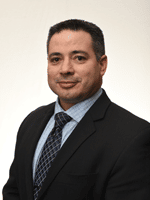This October during National Chiropractic Health Month, the American Chiropractic Association and doctors of chiropractic nationwide are working together to promote better access to non-drug therapies and remind people that chiropractic’s non-drug approach is on the frontline for pain management, offering evidence-based treatments that are safe and effective and that may help some patients to reduce or eliminate their dependence on prescription opioids. On the Healthy Living blog this month, we are sharing the stories of chiropractors who are “On the Frontline for Pain.”

David Paris, DC, works full time at the Veterans Healthcare Administration (VA) Redding Outpatient Clinic in Redding, Calif. He was previously in private practice for several years, exploring his interest in multidisciplinary healthcare settings via work with an occupational medicine clinic and the Sutter Health hospital system in Northern California. He started part time at the Redding VA Clinic in 2005 and transitioned to full time in 2008. Dr. Paris also serves as adjunct clinical faculty at several chiropractic colleges.
Q: What does a “day in the life” look like in your job?
A: Most days I’m doing clinical care and seeing veteran patients; it’s approximately 70% of my time here. I have four main “clinics” every day. Those are built around new patient referrals and consults; follow-up and established patient visits (the majority of my clinical time); walk-in/drop-in/same-day clinic for those patients with acute pain and more immediate needs; and a telehealth/telephone clinic for some follow-up visits, where appropriate.
I also have a few visits a month set up to serve as the originating site for telehealth visits to one of the pain management clinics—our closest is about three to four hours away. In this clinic, we serve as facilitators for any physical examination needs or direct patient contact.
About 20% of my time is dedicated to my role as a Whole Health Network Education Coordinator for VISN 21 (geographically, the U.S. is divided into Veterans Integrated Service Networks, or VISNs). In this role, we collaborate with multiple facilities’ points of contact to strategize and coordinate local, regional and national Whole Health training for VISN providers and staff. Whole Health is an exciting shift in the way we approach health care: it’s a more patient-centered, self-care focused approach that aligns around “What matters to you?”. It’s really exciting to watch this grow and is my favorite aspect of my job with the VA. More information is available here: https://www.va.gov/wholehealth/.
Q: Why did you want to become a chiropractor, and how did you end up working in the VA?
A: My personal interest all along was really one of “health” more than just seeing patients. Previously a gym rat, I was always attracted to exercise and rehabilitation as part of health care. One of my college roommates was going to Palmer College of Chiropractic West (PCCW) at the time so I went on a tour, loved the people and came to also love the place. On further investigation into the profession, I applied to PCCW and graduated in March 2001.
From my background I always had interest in multidisciplinary care and settings. While in private practice, I spent a few years working with a local occupational medicine (workers’ compensation) clinic and then a hospital system, filling in at five to six different clinics throughout the Sacramento and Bay Area. This experience taught me a lot about communication and reintroducing myself and the profession to other healthcare professionals. When the VA first advertised job openings in 2004, I was shocked to see an opening at the outpatient clinic in my small town. Back then there were about 25-30 candidates and now they’re seeing upwards of 300 for some positions. I was a longshot and feel lucky to have been hired. It’s been a wonderful career with a great work/life balance. It’s opened so many doors and opportunities both within the VA and the chiropractic profession at large.
Q: What type of injuries or pain do your patients experience?
A: Our veteran patient demographic leans toward our senior male population, but the percentage of female and younger veterans seems to be growing. I generally can see any musculoskeletal or pain-related issue, but given the data on efficacy for spinal-pain complaints, I tend to see a lot of those. Veterans tend to have a higher level of comorbidities—these include traumatic brain injury (TBI), post-traumatic stress disorder (PTSD), and amputees with and without prosthetics, etc. We treat a lot of chronic pain conditions, which can be very challenging, and this has inspired me to continue to learn and grow my skills in many areas.
Q: How do chiropractors help veterans?

A: We fill a tremendous need for evaluation and conservative management of musculoskeletal injuries and pain, with spinal-pain complaints leading the way. I think where we have differentiated ourselves in our general professional alignment and scopes of practice is in providing a Whole Health mindset. We focus on so many aspects of self-care, we focus on drug-free and non-surgical options along with diet and exercise, rehabilitation expertise, etc. In my humble opinion, we were Whole Health for the VA long before it was fully integrated and funded via the Office of Patient-Centered Care and Cultural Transformation (OPCC&CT), established in 2011. Personally, I believe we “tested the waters” for the value, need and desire for this broad aspect of Whole Health patient care while still providing a much needed, and highly requested, clinical service: conservative musculoskeletal pain care.
Q: What makes the chiropractic approach different?
A: I think it’s mainly the mindset and not necessarily the specific scope of practice. In the VA, many providers have overlapping scopes of practice, so I find that coming from a drugless, nonsurgical perspective that’s focused on self-care is extremely valuable. We establish personal connections with our patients. My experience is that the healthcare systems, including the VA, are becoming more patient-centered and connection-focused with patients, which is something I believe we’ve always done.
Q: Why is it important for veterans to have access to non-drug pain management options?
A: The opioid epidemic needs no introduction, and of course this presents a strong rationale for more non-drug or non-opioid care in any healthcare system, including the VA. But I think more importantly it presents the opportunity to really let veterans discover that: 1) there are more options than just drugs; 2) they can take charge of their own life and health; 3) they have support from their providers and the VA health care system to do this; and 4) that chiropractic care and other non-drug interventions can help them live better and healthier lives. We engage veterans more and offer personalized care, which seems to give them hope when there often isn’t any in their mind. On top of this, the current evidence tells us that not only should non-drug pain management be the first choice for most patients, but it also represents cost savings to healthcare systems.
Q: What does it mean to you to be “on the frontline for pain”?
A: Simply an honor. It’s a responsibility, and a challenge, that I take very seriously. We now know that what is said and what happens in the initial stages of a pain patients experience can determine their future health. As Dr. [Scott] Haldeman wrote about in Spine in 2008, the “supermarket” approach can still be presented to patients whether in our healthcare system, direct-to-consumer advertising or simply their own Google searches. It’s a daunting experience to be a pain sufferer, maybe now more than ever. My approach is to really have a discussion with veterans, not just about what hurts but about all the things that might be meaningful to them. I love doing informed consent from this perspective and laying out options for them, including my honest expectations for their involvement in self-care, etc. To have them choose to stay with not just conservative care or chiropractic but to choose to stay with me and at the VA is something that makes my job so personally rewarding.
Q: What is one thing that the public should know about chiropractic?
A: I believe every person should have a chiropractor much like they have a dentist or a primary care provider. From my perspective, the public needs to know that we are a trusted, reliable profession and not just a procedure, i.e. solely manipulative technicians. They should know that first and foremost we are doctors of chiropractic, emphasis on doctors. This means that we can be seen as reliable frontline partners in their healthcare team. This means increasing awareness of our full training and knowledge, skills and ability in diagnosis, ability/willingness to make appropriate referrals, and ability to provide care or education from a whole host of perspectives across manual therapy, rehabilitation paradigms, usual therapeutic modalities, and dietary or nutrition interventions. And in my view, most importantly, that we are the go-to providers for primary spine care. Finally, the public should be more aware that the evidence supports us.



